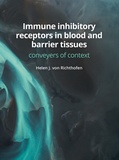Immune inhibitory receptors in blood and barrier tissues
Conveyers of context

Richthofen, Helen von
- Promoter:
- prof. dr. L. (Linde) Meyaard
- Research group:
- Inhibitory receptor lab
- Date:
- June 28, 2023
- Time:
- 12:15 h
Summary
The strength of the immune response needs to be tightly regulated: an immune response which is too strong can damage healthy tissue, while an immune response which is too weak can lead to the survival of pathogens or cancer cells. One of the ways by which the activity of the immune system is regulated is by the expression of inhibitory receptors. Inhibitory receptors dampen immune activation by blocking the signaling of activating immune receptors. In the first part of this thesis, we focus on one of these inhibitory receptors, named Signal Inhibitory Receptor on Leukocytes-1 (SIRL-1). We show that SIRL-1 is differentially expressed on myeloid cell subsets in blood and barrier tissues. In addition, we identify endogenous ligands of SIRL-1, namely S100 proteins. S100 proteins are released upon tissue damage, and are therefore considered DAMPs. We propose that recognition of S100 proteins by SIRL-1 may dampen immune responses to limit tissue damage. We describe that SIRL-1 is also activated by phenol-soluble modulins (PSMs) from Staphylococci and by the endogenous cathelicidin LL-37. These ligands have structural and functional similarities, such as an amphipathic α-helical structure. Based on this structure, we design synthetic amphipathic α-helical peptides which also activate SIRL-1. We therefore propose that SIRL-1 is an inhibitory pattern recognition receptor. Lastly, we show that SIRL-1 is shed from activated neutrophils, resulting in the release of soluble SIRL-1. This can be prevented by the protease inhibitor Eap from S. aureus. Thus, S. aureus has the ability to ligate SIRL-1 by secretion of PSMs, while at the same time maintaining SIRL-1 surface expression by secretion of Eap. This suggests that S. aureus may use SIRL-1 to evade immune activation.
In the last part of this thesis, we address the characteristics of inhibitory receptors more collectively. Based on literature, we describe several inhibitory receptors which recognize molecular patterns related to danger or homeostasis. We propose that these inhibitory pattern recognition receptors (iPRRs) provide environmental context to immune cells and thereby mediate appropriate immune responses. Finally, we review evidence for a regulatory role of inhibitory receptors on non-hematopoietic cells, focusing on epithelial and endothelial cells. Together, the findings in this thesis lead to improved understanding of inhibitory receptor biology, which can guide further research into the therapeutic targeting of these receptors in disease.